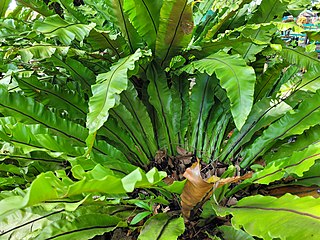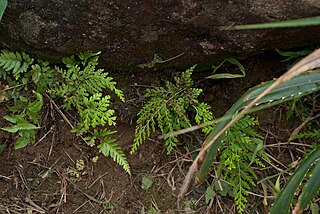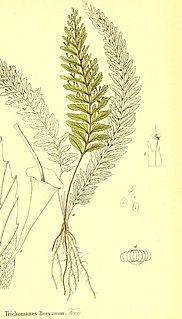
A fern is a member of a group of vascular plants that reproduce via spores and have neither seeds nor flowers. The polypodiophytes include all living pteridophytes except the lycopods, and differ from mosses and other bryophytes by being vascular, i.e., having specialized tissues that conduct water and nutrients and in having life cycles in which the branched sporophyte is the dominant phase. Ferns have complex leaves called megaphylls, that are more complex than the microphylls of clubmosses. Most ferns are leptosporangiate ferns. They produce coiled fiddleheads that uncoil and expand into fronds. The group includes about 10,560 known extant species. Ferns are defined here in the broad sense, being all of the Polypodiopsida, comprising both the leptosporangiate (Polypodiidae) and eusporangiate ferns, the latter group including horsetails, whisk ferns, marattioid ferns, and ophioglossoid ferns.

Lygodium is a genus of about 40 species of ferns, native to tropical regions across the world, with a few temperate species in eastern Asia and eastern North America. It is the sole genus in the family Lygodiaceae in the Pteridophyte Phylogeny Group classification of 2016. Alternatively, the genus may be placed as the only genus in the subfamily Lygodioideae of a more broadly defined family Schizaeaceae, the family placement used in Plants of the World Online as of November 2019.

Dicksonia is a genus of tree ferns in the order Cyatheales. It is regarded as related to Cyathea, but is considered to retain more primitive traits, dating back at least to the Jurassic and Cretaceous periods. The fossil record includes stems, pinnules, and spores.

Asplenium nidus is an epiphytic species of fern in the family Aspleniaceae, native to tropical southeastern Asia, eastern Australia, Hawaii, Polynesia, Christmas Island, India, and eastern Africa. It is known by the common names bird's-nest fern or simply nest fern.

Diplazium esculentum, the vegetable fern, is an edible fern found throughout Asia and Oceania. It is probably the most commonly consumed fern.

Musuan Peak or Mount Musuan, also known as Mount Calayo is an active volcano in Maramag, Bukidnon, on the island of Mindanao in the Philippines. It is 4.5 kilometres (2.8 mi) south of the city of Valencia, province of Bukidnon, and 81 kilometres (50 mi) southeast of Cagayan de Oro City.
Sphaeropteris elmeri, synonym Cyathea elmeri, is a species of tree fern native to the Philippines, Talaud Islands, and northern Sulawesi, where it grows in forest at an altitude of 500–1400 m. The trunk of this plant is erect and 5–10 m tall. Fronds may be bi- or tripinnate and up to 2 m or more in length. The lower surface of the rachis is distinctively pale and warty. The stipe is covered with scales and has warts towards the base. The scales are large, tapering, thin, and medium brown in colouration. Sori are borne near the fertile pinnule midvein. Indusia are absent.

Podogymnura truei, also known as the Mindanao gymnure, Mindanao moonrat, or Mindanao wood shrew, is a mammal of the family Erinaceidae. It is endemic to the Mindanao islands of the Philippines. Erinaceidae is a family of small mammals that include the gymnures, also known as the silky furred moonrats, and the hedgehogs. Animals belonging to this family are significant because they are among the oldest known placental mammals that are alive. Gymnures are relatives of hedgehogs but lack the prickly spines. Two species are categorized in the genus Podogymnura: P. aureospinula and P. truei. Both species share a close resemblance to the moonrat Echinosorex gymnura, which is commonly found on the Borneo, Sumatra, and the Malay Peninsulas.

Ficus nota is a species of flowering plant in the family Moraceae. It is commonly known as tibig or sacking tree, is a species of fig tree found near water in low altitudes. Tibig is native to the Philippines. They are also found in parts of northern Borneo in Malaysia.The tree can grow up to 9 meters high. It is primarily dispersed by birds which eat the fruits and excrete the seeds. The fruits are also edible to humans, although they are rather bland. They are usually eaten with sugar and cream in the Philippines. The young leaves are also eaten as a vegetable.

Lindsaeaceae is a pantropical family of ferns in the order Polypodiales. It contains six or seven genera with about 220 known species, some of which also extend into the more temperate regions of eastern Asia, New Zealand, and South America.

Phaleria is flowering plant genus of about 20-25 species in the family Thymelaeaceae.

The wildlife of the Philippines includes a significant number of endemic plant and animal species. The country's surrounding waters reportedly have the highest level of marine biodiversity in the world. The Philippines is considered one of the seventeen megadiverse countries as well as global biodiversity hotspot. In the 2000 Red List of the International Union for the Conservation of Nature and Natural Resources (IUCN), 418 of the country's 52,177 species were listed as threatened.

Grammitidoideae is a subfamily of the fern family Polypodiaceae, whose members are informally known as grammitids. It comprises a clade of about 750 species. They are distributed over higher elevations in both the Old and New World. This group was previously treated as a separate family, Grammitidaceae until molecular phylogenies showed it to be nested within the Polypodiaceae. It has since been treated as an unranked clade within subfamily Polypodioideae, and, most recently, as a separate subfamily.

Plenasium banksiifolium is a fern in the family Osmundaceae. The genus Plenasium is recognized in the Pteridophyte Phylogeny Group classification of 2016 (PPG I); however, some sources place all Plenasium species in a more broadly defined Osmunda, treating this species as Osmunda banksiifolia. It is native along the Pacific coast of Asia, being found in the Kamchatka Peninsula, the Ryukyu Islands, Japan, southeast China, Taiwan, the Philippines, Borneo, Sulawesi and Java. P. banksiifolium, which can reach a height of 1.5 m, is the largest species in the genus and has ornamental value.

Melanthera biflora, also known as sea daisy, beach daisy and sea ox-eye, is a species of flowering plant in the family Asteraceae. It is a scandent, rough-looking and fast-growing plant with a wide distribution.

Odontosoria chinensis is a fern in the family Lindsaeaceae. Commonly called lace fern, it is native from India to Hawai'i, and south to Sumatra, Borneo and the Philippines, as well as other parts of the tropics and sub-tropics. It is commonly found in forest openings and disturbed areas such as landslides, along trails or roads. It grows in moist, shady areas from sea level to an elevation of 4,000 feet.

Tubho tea, is a traditional herbal tea of the Ivatan people in the Philippines made from dried leaves of the tubho fern.

Cephalomanes atrovirens is a species of fern in the family Hymenophyllaceae. The genus Cephalomanes is accepted in the Pteridophyte Phylogeny Group classification of 2016, but not by some other sources. As of October 2019, Plants of the World Online sank the genus into a broadly defined Trichomanes, while treating the subtaxa of this species as the separate species Trichomanes acrosorum, Trichomanes atrovirens, Trichomanes boryanum and Trichomanes kingii.
Sphenomeris is a genus of ferns in the family Lindsaeaceae.

Odontosoria is a genus of ferns in the family Lindsaeaceae.

















